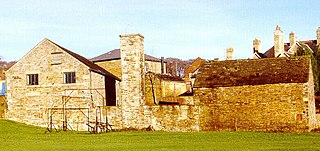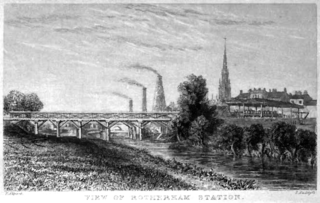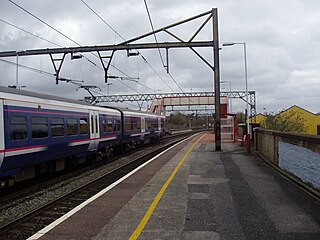Millhouses engine shed was an engine shed in Millhouses, Sheffield. It was built by the Midland Railway in 1901 as Ecclesall engine shed, to serve the Midland Main Line. It was used mainly to stable passenger and mixed-traffic locomotives for use on trains from the nearby Sheffield Midland station. The shed was built next to Millhouses railway station; it had 8 dead end roads, and could handle about forty steam locomotives. Ecclesall shed was renamed Millhouses in 1920. Millhouses bore the shed code 25A, then 19B in 1935 and finally 41C in 1958.
During LMS ownership the shed was home mostly to 4-4-0 engines until the arrival of Jubilee steam engines in 1937. In 1959 the shed had an allocation of thirty-three engines, including twelve Jubilee steam engines. 1960 saw the arrival of seven Royal Scots.
Millhouses shed closed on 1 January 1962, the shed's remaining engines were transferred to Canklow, Barrow Hill Engine Shed and Staveley Great Central.
In December 2015 it was demolished and the site is now on the market as development land.
The former shed yard is now the home of the large Tesco supermarket on Abbeydale Road

Ecclesall Ward—which includes the neighbourhoods of Banner Cross, Bents Green, Carterknowle, Ecclesall, Greystones, Millhouses, and Ringinglow—is one of the 28 electoral wards in the City of Sheffield, England. It is located in the southwestern part of the city and covers an area of 3.6 square miles. The population of this ward in 2007 was 19,211 people in 7,626 households, reducing to 6,657 at the 2011 Census. Ecclesall ward is one of the four wards that make up the South West Community Assembly and one of five wards that make up the Sheffield Hallam Parliamentary constituency. The Member of Parliament is Olivia Blake, a Labour MP. Ecclesall is one of the least socially deprived wards in the entire country, with a 2002 deprivation score of 4.7—making it the 8,105th most deprived ward out of 8,414 wards in the country. The demographic consists largely of white, middle-class families.

The London, Midland and Scottish Railway (LMS) Jubilee Class is a class of steam locomotive designed for main line passenger work. 191 locomotives were built between 1934 and 1936. They were built concurrently with the similar looking LMS Stanier Class 5 4-6-0. They were nicknamed Red Staniers and Jubs.


The Midland Railway – Butterley is a heritage railway and museum complex at Butterley, near Ripley in Derbyshire.

Millhouses is a neighbourhood in the City of Sheffield, England. It is located in Ecclesall ward; in the south-western portion of the city on the northwest bank of the River Sheaf. Its origins lie in a small hamlet that grew around the Ecclesall Corn Mill. It has a population of 4,424.

Dore & Totley railway station serves the south-western Sheffield suburbs of Dore and Totley in South Yorkshire, England 4+3⁄4 miles (7.6 km) south of Sheffield. The station is served by the Northern service between Sheffield and Manchester, East Midlands Railway service from Liverpool to Norwich and the TransPennine Express service between Manchester and Cleethorpes, all three running via the Hope Valley Line.

The Sheffield and Rotherham Railway was a railway line in England, between the named places. The North Midland Railway was being promoted but its route was planned to go through Rotherham and by-pass Sheffield, so the S&RR was built as a connecting line. It opened in 1838. In Sheffield it opened a terminal station at Wicker, and in Rotherham at Westgate. When the NMR opened in 1840 a connecting curve was made between the two routes.

Bradway Tunnel, 1 mile 266 yards (1.853 km) long, was built in 1870 about 1-mile (1.6 km) north of Dronfield, Derbyshire, in South Yorkshire, England.

Bidston railway station is a railway station that serves the village of Bidston, Merseyside, England. The station is situated at the junction of the West Kirby branch of the Wirral line, which is part of the Merseyrail network, and serves as the northern terminal for the Borderlands line from Wrexham Central, operated by Transport for Wales.

Ashburys railway station is in Openshaw, Manchester, England, on the Manchester-Glossop Line at its junction with the Hope Valley line and the freight line to Phillips Park Junction. It has been open since 1855 and is the nearest railway station to the City of Manchester Stadium.

Tinsley was a railway marshalling yard near Tinsley in Sheffield, England, used to separate railway wagons from incoming trains and add them to new trains. It was sited immediately west of the M1 motorway, about one mile north of the Catcliffe junction. It was opened in 1965, as a part of a major plan to rationalise all aspects of the rail services in the Sheffield area; it closed in stages from 1985, with the run-down of rail freight in Britain. It was also the site of Tinsley Traction Maintenance Depot (TMD), which was closed in 1998; at its peak, 200 locomotives were allocated to this depot.

Millhouses and Ecclesall railway station was a railway station in the Millhouses district of Sheffield, South Yorkshire, England.
Grimesthorpe engine shed was an engine shed in Grimesthorpe, Sheffield. It was built by the Midland Railway and opened in 1860 to serve the Midland Main Line. Up until 1935, Grimesthorpe shed code was 25, then changed to 19A by the London, Midland and Scottish Railway. Grimesthorpe gained the shed code of 41B after transfer to British Railways Eastern Region in 1958.

London, Midland and Scottish Railway (LMS) Jubilee Class No. 5699Galatea is a preserved British steam locomotive.
The Sheffield District Rail Rationalisation Plan was a series of linked railway civil engineering projects, station and line closures and train route changes that took place in and around Sheffield, South Yorkshire. The majority of these changes took place in the 1960s and early 1970s, however the plan, by now much modified in the face of rapidly dwindling freight traffic, was not fully realised until the 1980s.
Nunnery engine shed was a small locomotive depot close to the city centre of Sheffield, South Yorkshire, England.

Tinsley Motive Power Depot, latterly Tinsley Traction Maintenance Depot (TMD), was a railway depot in Tinsley, South Yorkshire, near Sheffield. Access by road was from Brinsworth, near Rotherham. The depot was situated on the freight line between Treeton Junction and the A631 Shepcote Lane.

Barnoldswick railway station was the only railway station on the Midland Railway's 1-mile-64-chain (2.9 km) long Barnoldswick Branch in the West Riding of Yorkshire in England. It served the market town of Barnoldswick, which was in West Riding of Yorkshire at the time. The line left the Leeds and Bradford Extension Railway at Barnoldswick Junction 55 chains from Earby railway station. The line through the junction was on a 20-chain radius after which it converged to a single track and ran in a straight but undulating line to Barnoldswick. The passenger train that ran back and forth between Barnoldswick and Earby was known locally as the 'Barlick Spud' or 'Spudroaster'. The real reason for the name is lost in time, but the two versions that were commonly recited are that the original branch locomotive was so small it looked like a portable potato roaster used by a local vendor or that the journey time was the same as that taken to roast a potato in the locomotive's firebox.

Gorton Locomotive Works, known locally as Gorton Tank, was in West Gorton in Manchester, England and was completed in 1848 by the Sheffield, Ashton-under-Lyne and Manchester Railway.
There were a number of engine sheds and railway works located in York. The large York North engine shed became the National Railway Museum in 1975.